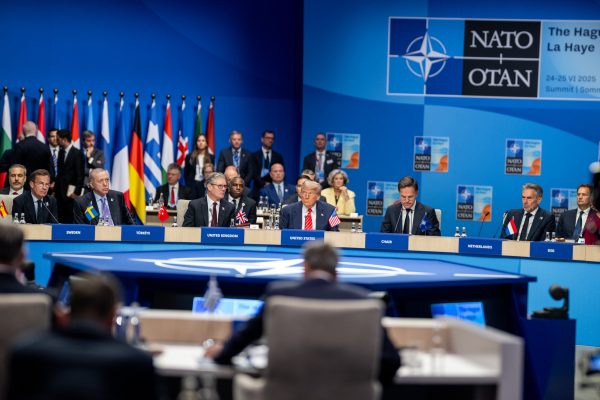On June 24–25, all 32 member countries of NATO gathered in The Hague, Netherlands. The main focus of the summit was to strengthen defense spending.
NATO Summit Focused Elsewhere on Defense Spending
Leaders also aimed to keep the NATO alliance united. This came after recent uncertainty caused by political tensions. During the summit, member countries agreed on a non-binding deal. Each country will aim to spend 3.5% of its GDP on defense by 2035. They also made another financial commitment. Countries will spend 1.5% of GDP to improve roads, ports, and airfields. This upgraded infrastructure will help move troops quickly in case of emergencies.
While this financial commitment was seen as progress, it came with a downside. A large part of the discussions seemed to focus on making sure the U.S. stays committed to NATO, especially after U.S. President Donald Trump hinted he might pull back support. NATO leaders pushed aside some of the alliance’s most urgent threats, like North Korea. Although previous summit agendas included North Korea’s name, leaders barely discussed it this time—even as its military support to Russia in Ukraine continues to grow rapidly.
North Korea’s Support to Russia Is Dangerous and Active
Since Russia invaded Ukraine in 2022, the war has become Europe’s biggest land conflict since World War II. But it’s no longer just between Russia and Ukraine. North Korea has entered the scene, sending both weapons and soldiers to support Russia. In late 2024, reports revealed that 10,000 to 14,000 North Korean troops were sent to Russia’s Kursk region. These troops are helping Russia hold back Ukrainian forces. As of mid-2025, more than 6,000 North Korean soldiers have died or been wounded in the conflict.
UK shocks NATO summit with massive nuclear-capable F-35A fighter jet order
Besides soldiers, North Korea is supplying a huge amount of weapons. A 2025 investigation by Reuters found that Pyongyang was giving Russia over half of the artillery shells used in Ukraine. A May 2025 report by a Multilateral Sanctions Team also showed that North Korea is sending large numbers of ballistic missiles to Russia. These weapons have been critical in slowing down Ukraine’s military momentum.
Despite this growing role in the conflict, NATO leaders barely mentioned North Korea during the recent summit. Some countries may now see the war in Ukraine as something that is just “ongoing” and no longer needs top attention. But ignoring North Korea’s involvement is risky and leaves NATO exposed to threats from not just the battlefield—but from within their own borders.
Cyber Threats and Spy Risks in NATO’s Backyard
One of the most dangerous and underreported threats is the presence of North Korean IT workers inside organizations across Europe and North America. A report by Google’s Threat Intelligence Group (TAG) in April 2025 revealed that North Korean hackers are working undercover as IT professionals in various fields—including aerospace, defense, and tech industries—which are all vital to NATO’s military planning and supply chains.
While some discussions at the summit mentioned North Korean cyberattacks, these were mostly about stealing cryptocurrency to fund missile programs. However, this view is too narrow. These undercover IT workers pose a direct threat to NATO’s security. They are gaining trusted roles inside companies, allowing them to access sensitive data related to military supplies, defense technologies, and even weapons delivery schedules.
🛡️ NATO unity rattled as Spain defies 5% defense pledge, Trump threatens sanctions
Because IT workers are often responsible for managing entire information systems, they can collect valuable data about NATO’s rearmament plans or active missions. Even more concerning, they could use their access to recruit insiders, sabotage data systems, or secretly install malware. This kind of damage could slow down weapon shipments to Ukraine or expose NATO strategies to Russian or North Korean intelligence.
South Korea Shift and Spy Threats Expose NATO
A serious concern is the possibility of this stolen information reaching Moscow. If North Korea passes data about weapons delivery routes or shipment times to Russian forces, those shipments could be targeted and destroyed. This would weaken Ukraine’s defense and give Russia an upper hand, especially in critical regions like Donbas.
NATO’s new push to boost its defenses also brings more risks. The more NATO spends on weapons and tech, the more attractive its industries become to enemy spies. European defense firms and supply companies could be unknowingly hiring North Korean agents, who would then be in a position to leak or damage critical data and systems.
Dutch Far-Right Uprising? Geert Wilders’ Exit Triggers Political Earthquake Before NATO Summit
Additionally, with South Korea recently electing President Lee Jae-myung, NATO’s opportunity to closely work with Seoul may be shrinking. Lee skipped the NATO summit, signaling he may take a more neutral approach to foreign policy—possibly warming relations with North Korea, China, or Russia. This is troubling because South Korea has been a major arms supplier to Europe, and its insight into North Korean threats is unmatched.
If South Korea steps back from NATO partnerships, the alliance could lose a key partner in identifying and countering North Korea’s hybrid warfare strategies. This includes both military and cyber actions that stretch across continents—from East Asia to Eastern Europe.

